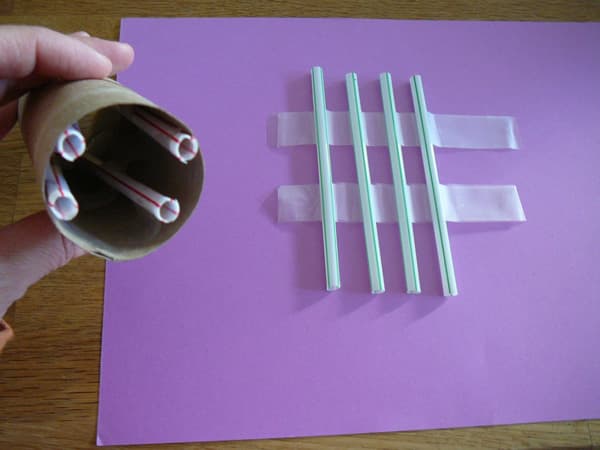Lesson Two: True Fly Proboscis Model
Question
How does the house fly eat?
Objective
Students and teacher will build a simple model of how a fly eats with its proboscis.
Materials
One paper or toilet roll for each student, about 6 inches tall and 2 inches in diameter, 4 or 5straws cut to the same height as the black tube, and clear tape. See figure 5.
Figure 5

Directions
1. Tape the straws together with a little space between.
2. Place the straws inside the tube and tape.
3. Explain that this is a model of the house fly's proboscis which is folded under the fly's head and extended when it is eating. The straws in the model represent the tubes that carry the house fly's saliva to solid food. These tubes are called the pseudotracheae. The food is dissolved by the fly's saliva and the fly sucks in the liquid food with muscles in the upper part of the proboscis. Label the muscles on a piece of tape and place near the top of the model. The fly can only drink liquids. It has no structures for chewing its food like the dragonfly. The labium, or bottom lip which is also present in the dragonfly, has been adapted to form the proboscis. The other mouthparts present in the dragonfly are no longer recognizable in the true fly.
Discussion
Sit in a circle with the students and have students think, pair, and then share with the group about the question. Why did the housefly evolve to have a proboscis? Some ideas to discuss and think about: The proboscis allows the fly access to a variety of foods. House flies don't have to hunt for live food to get a blood meal, like horse flies.
Independence
Allow students to construct the proboscis model with a buddy class and teach the other students what they've learned about the structures of the fly's proboscis.
Extensions
1. Students will use 3-5 straws and drink liquid like a fly through multiple straws.
2. Compare the mouthparts of other insects. Students will look at the curved tube proboscis of butterflies and moths or the piercing and sucking mouthparts of the mosquito.
3. Students will create their own mouth adaptation for a fly. In what environment is your fly using their structure? Have students do a brief presentation using a model.

Comments: